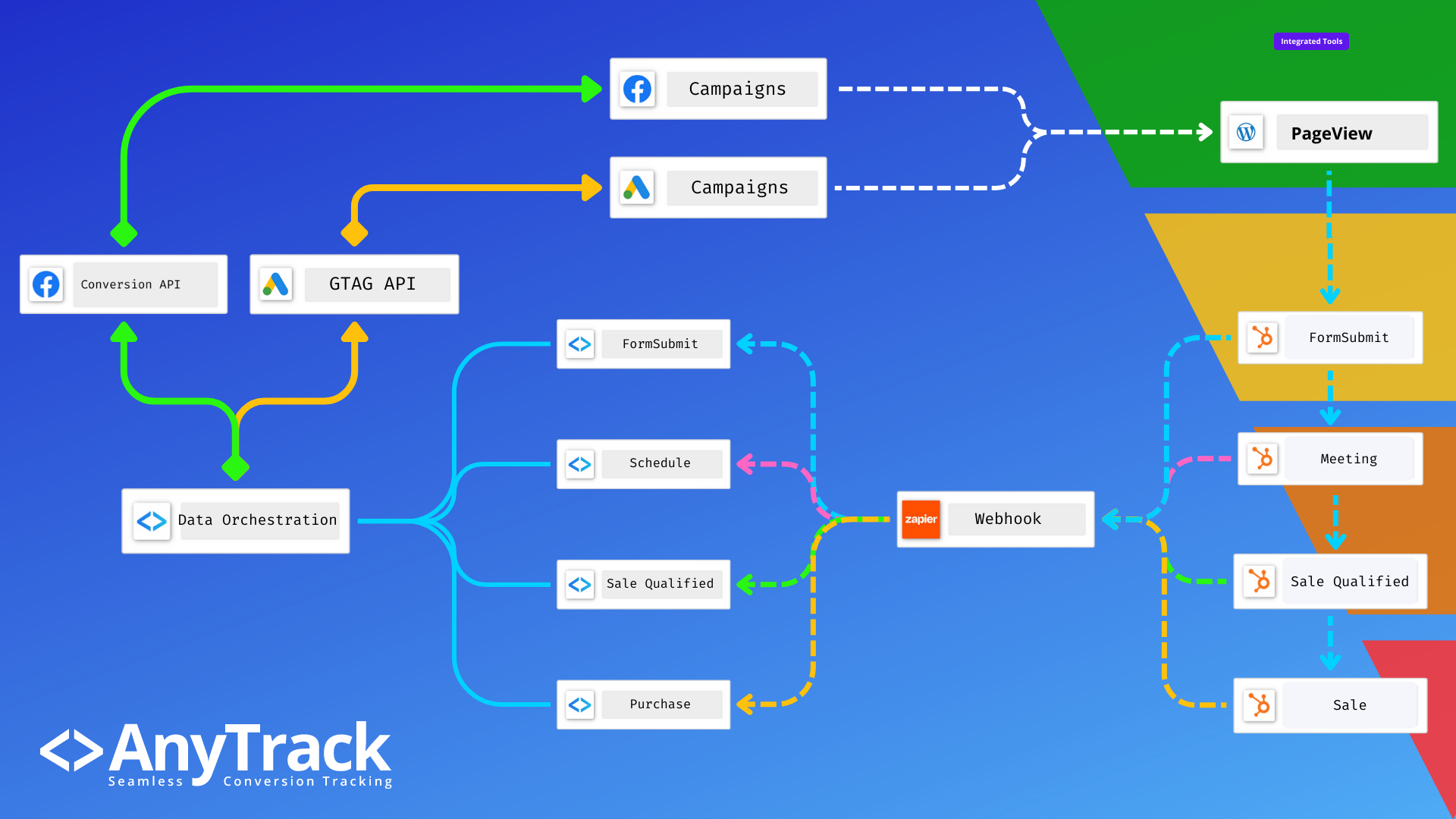Tracking Customer Lifecycle with Ad Platforms
Learn how to track customer lifecycle with Ad platforms using AnyTrack.io to help you maximize ROAS and streamline conversion data across your marketing stack.
Discover how to track and attribute your customer lifecycle with ad platforms like Google Ads and Facebook Ads. This comprehensive guide shows you how to use AnyTrack to send conversion data and audience data through each respective Conversion API, and outlines the traffic and data flow between ad networks, your website, and Hubspot CRM. Learn how to optimize your ad spend and improve your ad campaign attribution by mapping events to conversion actions and audiences.
Traffic and Data Flow
The traffic and data flow between ad networks like Google Ads and Facebook Ads and the customer website and CRM is as follows:
- Ad Platforms: Visitors click on your Google Ads or Facebook Ads, which leads them to your website.
- Website: Visitors land on your website and fill out a form.
- Hubspot CRM: The form data is sent to Hubspot CRM, where sales representatives book meetings and call potential customers.
- Customer Lifecycle: Potential customers move through a customer lifecycle, and eventually purchase your service.
- AnyTrack: The data flow is triggered by each lifecycle event and the lifecycle-associated data is sent to AnyTrack by Hubspot, via Zapier webhook integration.
- Conversion API: AnyTrack is then responsible for sending conversion data and audience data to Google Ads and Facebook Ads, through each respective Conversion API (gtag API and Facebook Conversion API).

Conversion data flow for Hubspot Customer Lifecycle events in Google Ads and Facebook Ads
Conversion Data and Audience Data
It is important to outline the type of data that is sent to each ad platform's Conversion API improve their ad campaign attribution. Following recommend parameters and customer data sent from Hubspot will enable AnyTrack to map such parameters with those of your Ad Platforms - for example, email, phone.
Google Ads Conversion Data
- In Google Ads, create a conversion goal for each lifecycle event you want to track.
- Update the conversion goal's settings (count, attribution window, category etc...).
- Set the primary or secondary setting according to what your campaigns should optimize for.
- The
Purchaseevent should be set with dynamic conversion value, as long as you send this value from Hubspot.
- In AnyTrack, connect with your Google Ads Tag, enable the Conversion API
- Map the the AnyTrack Conversion Goals to the Google Ads Conversions
- Get your URL tracking template and add it to your Google Ads account.
From this point on, conversions will be sent to your Google Ads account according to the event mapping you just defined.
Audience Data
AnyTrack feeds your ad platform's pixels with granular data that can be used to create custom audiences according to each event type and attributes.
By following the recommended conversion attributes, you'll be able to leverage every meaningful data point collected through online and offline interactions.
Conversion Event Mapping Orchestration
Finally, it is important to outline the conversion event mapping orchestration between what is triggered in Hubspot, what is received in AnyTrack, and what is sent to the ad platforms. The conversion event mapping orchestration is as follows:
- Hubspot: You set up your Hubspot CRM to trigger events based on customer lifecycle stages, such as "Lead Created" or "Opportunity Closed".
- Zapier: You use Zapier to create a webhook integration between Hubspot and AnyTrack.
- AnyTrack: AnyTrack receives the webhook from Hubspot and maps the event to a conversion action and audience.
- Conversion API: AnyTrack sends the conversion data and audience data to Google Ads and Facebook Ads through each respective Conversion API.
By mapping events to conversion actions and audiences, you can get a better understanding of which ad campaigns are driving the most valuable traffic to your website and CRM. This allows you to optimize your ad spend and improve your ad campaign attribution.
Conclusion
In conclusion, AnyTrack is a powerful tool for tracking conversions and audiences and sending that data to Google Ads and Facebook Ads through each respective Conversion API. By understanding the traffic and data flow between ad networks like Google Ads and Facebook Ads and your customer website and CRM, and by paying attention to the quality of the data that you send to each Conversion API, you can improve your ad campaign attribution and make better-informed decisions about your ad spend.
Updated 5 months ago